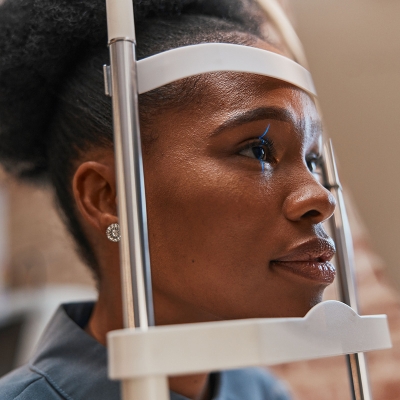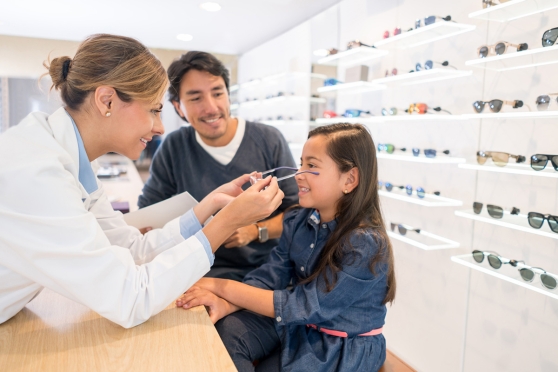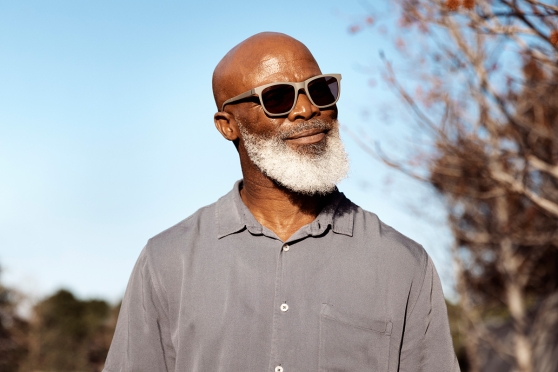These sports may be putting kids’ eyes at risk
Have a child athlete? Find out how to protect their vision if they play certain sports.

Sports may be a great way to keep children active, social, happy and healthy. But certain sports may also increase a child’s risk of getting an eye injury.
Annually, children playing sports in the United States experience more than 20,000 eye-related injuries.1 Baseball causes the most sports-related eye injuries in children ages 5 to 14, according to the American Academy of Ophthalmology (AAO).2 There’s the possibility of a child getting hit in the eye with a baseball, of course, but also potentially a bat or glove. There’s also a chance of getting poked in the eye during a collision or catch — or even getting sand in their eye while sliding into home.
But here’s some good news: Whether a child is playing baseball or another sport, there may be ways to protect their eyes from injuries. What might parents do to keep their child’s vision safe? Read on to learn more.
Stay on top of your child’s eye health with an in-network provider. Search for a provider now.
What other sports may put a child’s eyes at risk of injury?
While the AAO singles out baseball as the sport that causes the most eye injuries among young children and teens, they also list a number of other sports that may be dangerous to a child’s eyesight. These include:3
- Basketball. According to one study, basketball may cause the most overall eye injuries in the United States.3 A child may be hit with a hard-rubber basketball or poked in the eye by another player’s finger.
- Hockey. A child may be hit by a fast-moving, hard hockey puck or stick.
- Racquet sports. A child may be struck by a high velocity ball or racket.
- Softball. A child may be struck by a hard ball that’s larger than a baseball, or by a bat or glove (similar to baseball).
In addition, the AAO notes that contact sports such as martial arts or boxing may put a child’s eyes at the greatest risk — and could even cause blindness.
How might a parent or coach know if a child’s eye injury is serious?
“All traumatic injuries to the eye should be considered urgent until evaluated by a doctor of optometry,” says Jacqueline M. Bowen, O.D., an eye care provider in Greeley, Colorado.
If a child is struck by a piece of athletic equipment, the AAO says it may be important to look out for the following symptoms that could indicate an emergency:4
- A change in pupil size or shape
- A tear or cut to the eyelid
- An eye that may bulge from the socket
- An eye that may not move the same way as the other one
- An object in the eye that may not come out with tears or blinking
- Blood that may be visible in the clear part of the eye
- Decreased vision
- Pain in the eye that may not stop
What might a parent or coach do after a child gets a sports-related eye injury?
Immediately after a potential eye injury, it’s a good idea to treat it on the spot. For example, if a child gets hit in the eye, the AAO recommends gently applying a small cold compress to reduce pain and swelling. It may not be a good idea to use frozen foods as the cold compress, as they could get bacteria into the eye. It’s also not a good idea to apply pressure to the injury.4
But it may be difficult to tell how severe a child’s eye injury may be. So, it’s a good idea to check with a child’s doctor or eye care provider — or in more serious situations, seek emergency medical attention. “Many local doctors of optometry are on call for emergencies,” says Dr. Bowen. “Also, local urgent care centers, hospitals or doctors near an accident can assist a patient, depending on what the emergency issue is.”
How might parents protect children’s eyes while they’re playing sports?
Parents may not always be able to check on their child athletes every step of the way. But they may feel better if their children’s eyes are better protected against injury. According to the AAO, more than 90% of eye injuries may be prevented by children using suitable protective eyewear.
These tips may be helpful in keeping your children’s eyes safe:2, 3
Tip #1: Avoid projectiles. Ensure that a child avoids sports or activities that involve projectile equipment, such as darts, arrows or pellets/bullets. If they must take part, it may be a good idea to drive home how to safely use the equipment and how to avoid injury.
Tip #2: Be vigilant. Keep a careful watch on the sport a child may be playing. It may be a good idea to stop them from playing it if it causes regular injuries to their eyes or other parts of their body.
Tip #3: Emphasize safety. It’s important for children to know how to use sports equipment correctly and safely, whether they’re playing baseball, basketball, hockey or another activity.
Tip #4: Get them the right eye protection. Make sure children have and wear protective glasses while playing sports that may cause eye injuries. Parents will want to get them eyewear with shatterproof polycarbonate plastic lenses. (Polycarbonates are strong, tough materials made from chemicals.) Some sports require the use of special sports glasses that have standards according to the American Society for Testing and Materials (ASTM), to ensure that glasses don’t break when hit by a fast-flying ball. These types of glasses apply to sports such as racquet sports, baseball, basketball, soccer and tennis.5
Tip #5: Provide safety tips. It may be a good idea to walk a child through how to use certain types of sports equipment. That could also include how to properly wear protective eyewear.
The bottom line: It may not be too early for children to learn the importance of protecting their vision — especially those that play sports. Whether that be from a parent or eye care provider, that knowledge may help keep their eyes healthy for a lifetime.
Providers in the UnitedHealthcare Vision Network are here to help keep your child’s vision healthy. Search for a provider now.
Sources:
- Ocular related sports injuries The Journal of Craniofacial Surgery, June 2022.
- Children’s eye injuries: prevention and care American Academy of Ophthalmology, April 2023.
- Sports eye safety American Academy of Ophthalmology, January 2024.
- Recognizing and treating eye injuries American Academy of Ophthalmology, April 2023.
- Recommended sports eye protectors Prevent Blindness Texas


